by Susan Johnston | Nov 4, 2019 | Get people talking |
 “Running good meetings is THE most important thing we do. I can’t understand why more people don’t understand that.”
“Running good meetings is THE most important thing we do. I can’t understand why more people don’t understand that.”
So says a Scrum Master (and wise colleague) I spoke with recently. I was explaining (OK, complaining) that I can fill a coaching course in a few days, but there seems to be less appetite for facilitation workshops. And why would that be so?
“Maybe nobody knows what facilitation is,” said my friend. “Could you rebrand it?”
HARNESS THE POWER OF THE GROUP
If team or group members have to set direction, make decisions, plan collaborative action, solve a problem or sort out an issue, someone trained in facilitation is a huge help. Good facilitators know how to create conditions where people can share ideas, express opinions and discuss them in a productive way. Facilitators develop and follow a process that encourages participation, discovery, discussion, deliberation and good decisions. In short, good facilitation helps people think better together.
As the role of leaders and managers evolves from giving directions to setting direction, and from taking control to giving control, these skills become increasingly important. A facilitative leader can harness the power of the group.
A facilitator helps a group free itself from internal obstacles so a meeting’s desired outcome can be pursued efficiently and effectively. Chinese philosopher Lao-Tse described this, over 2,400 years ago. “A good leader is best when people barely know that he leads. A good leader talks little, but when the work is done, the aim fulfilled, all others will say, ‘We did this ourselves.’ “
In a more recent century, Tom Kayser wrote in his book, Mining Group Gold, “In the purest sense, when wearing the ‘facilitator’s hat,’ an individual acts as a neutral servant of the people. By that I mean that the person focuses on guiding without directing, bringing about action without disruption, helping people self-discover new approaches and solutions to problems, knocking down walls that have been built between people while preserving structures that are of value and, above all, appreciating people as people. All of this must be done without leaving any fingerprints.”
Facilitation skills create and maintain an environment or “container” for the group, where productive discussions can lead to good decisions. In other words, meetings don’t waste people’s time.
Our next workshop takes place APRIL 30-MAY 1, 2020 in Toronto.
YOU CAN LEARN TO MAKE MEETINGS MATTER
With collaboration and teamwork as hallmarks of Agile work, facilitation becomes a key skill for Scrum Masters, Product Owners, Agile Coaches and anyone who leads teams and/or meetings.
That’s why, in early 2016, I developed a two-day workshop to teach it – Facilitation for an Agile Workplace. Successful completion earns participants International Consortium for Agile (ICAgile) team facilitation certification, the ICP-ATF. Ellen Grove joins me in leading this workshop, adding her long perspective and experience as a coach and trainer to mine.
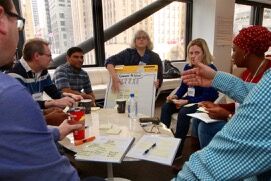 Workshop participants explore the facilitator’s stance and mindset along with the pattern of a successful meeting. Then we get practical. We share tools you can use, right away, for planning, gathering data, generating insights and deciding what to do. We explore maintaining neutrality, team dynamics, dealing with difficult situations (or people).
Workshop participants explore the facilitator’s stance and mindset along with the pattern of a successful meeting. Then we get practical. We share tools you can use, right away, for planning, gathering data, generating insights and deciding what to do. We explore maintaining neutrality, team dynamics, dealing with difficult situations (or people).
Of course, we look at facilitating Agile practices. And we’ve built a visual facilitation component throughout the two days, to bring the power of visibility, so important in agile practice, to our facilitation.
I COULD SAY MORE BUT . . .
it might make more sense to hear from folks who’ve been part of our workshop:
- “This training has made me realize how facilitation techniques and mindset can help Agile teams to communicate better and achieve next level of self realization.”
- “This program was great at teaching the arc of facilitation and the planning that a skilled facilitator should do when preparing for a session. I learned a great deal from the course and have been putting these skills into practice with excellent results!”
- “By taking facilitation skills workshop, it changed my perspective about what a good facilitator is, and it brought to me techniques and tools to pull out the most of a team meeting.”
- “Sue and Ellen put a lot of thought and effort into putting the workshop together that may not be evident during the training, since they conducted it with ease and flow. However each of the activities served a purpose in driving home the important points of the material. Excellent workshop and highly recommended!”
- “Agile Facilitiation Skills workshp definitely changed my perspective about facilitation. It provided me the tools, framework and strategies to better engage the audience in an agile way.”
- “Ellen and Sue provide a wonderful course that has tools and tricks that are practical and can be applied to your job immediately. As facilitators, they provide tremendous energy and bring a safe and joyful atmosphere over the course of two days.”
- “I had an opportunity to attend “Facilitation Skills for the Agile Workplace 2.0″ taught by Sue and Ellen. They are both are amazing, talented and passionate facilitators. Course contents were very well taught and explained. Sessions had enough hands-on activities which helped us understand practical implementation of what we learnt.”
- “Amazing class! I applied what I learned the next day and every day since. Sue and Ellen did a fantastic job facilitating and gave us tons of great techniques with enough time to practice. If you interact with people, take this class. You won’t be disappointed.”
 Facilitation is much more interesting and valuable than people recognize. Maybe that’s because, when done well, it’s almost invisible. So, I think my Scrum Master friend is right. (He often is.) Let’s rebrand facilitation. Let’s call it “Decision Making, Effective Communication and Awesome Teamwork for Any Workplace.”
Facilitation is much more interesting and valuable than people recognize. Maybe that’s because, when done well, it’s almost invisible. So, I think my Scrum Master friend is right. (He often is.) Let’s rebrand facilitation. Let’s call it “Decision Making, Effective Communication and Awesome Teamwork for Any Workplace.”
Our next workshop takes place APRIL 30-MAY 1, 2020 in Toronto.
Facilitation for an Agile Workplace meets the requirements for ICAgile’s Agile Team Facilitator certification.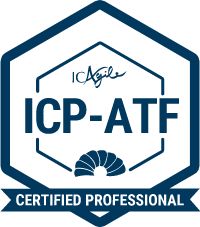
by Susan Johnston | Apr 9, 2019 | Uncategorized |
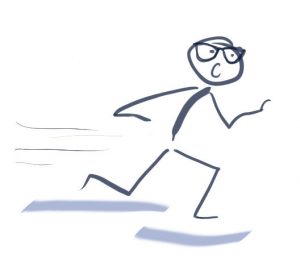 “Half (of the meetings I attend) are completely bizarre and accomplish nothing except bewildering me as to why people don’t run out screaming.” That’s a real quote from a real person about real meetings. Yes, it’s sad. It showed up in an informal survey I did some time ago. Folks told me they spend approximately 40 per cent of their time in meetings, a number consistent with data Perlow, Hadley and Eun found in their 2017 Harvard Business Review Article, “Stop the Meeting Madness.” The authors also found that:
“Half (of the meetings I attend) are completely bizarre and accomplish nothing except bewildering me as to why people don’t run out screaming.” That’s a real quote from a real person about real meetings. Yes, it’s sad. It showed up in an informal survey I did some time ago. Folks told me they spend approximately 40 per cent of their time in meetings, a number consistent with data Perlow, Hadley and Eun found in their 2017 Harvard Business Review Article, “Stop the Meeting Madness.” The authors also found that:
– 71% felt that meetings waste their time
– 65% said meetings keep them from doing their real work
– 66% claim meetings inhibit spending time on deep thinking
Calculate the hard cost of bringing minds together to explore issues, make decisions and plan action. It’s often thousands of salary dollars for a one-hour meeting. (And that doesn’t count travel, doughnuts or the opportunity cost when we delay getting to our other work.)
Then ponder another response, from my survey. “We can’t make decisions or agree on priorities. So, we have the same meeting over and over. Literally, the same meeting.” 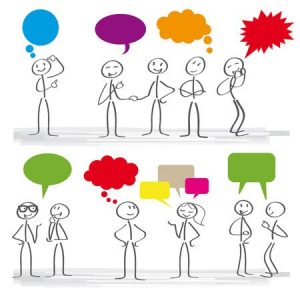
Imagine if every meeting you went to felt like a good investment of your time. It can happen. Good facilitation enables conversations that lead to good decisions. It requires planning – a whole lot more than finding a conference room and sending out a meeting notification.
The first step is identifying the purpose of the meeting, the desired outcome. That leads you to determine who needs to be there – really – and what they need to provide or do. How will you engage people? How will you gather information, analyze it, decide what to do and follow up? All this should be planned before the meeting.
That’s Plan A. You’ll need a Plan B, too, since humans are involved. And you’ll need to be ready to change your plans. Still, to go into meeting a without a plan is almost guaranteed to be a time waster. The more thought and time you invest in planning the meeting, the more relevant and useful the discussion will be – for you and for the participants.
Given that today’s working environment requires collaboration, teamwork and communication, learning to facilitate well may be the most important skill for the 21st century. A facilitator doesn’t do magic. It just looks that way.
+++++++ At It’s Understood Communication, we care about facilitation. Facilitation Skills for the Agile Workplace is a two-day workshop that offers a solid foundation in facilitation, including using visual thinking to build clarity and understanding. Ellen Grove and Sue Johnston are offering it in downtown Toronto, May 6-7, 2019. There are still a few spots left. To learn more and register, visit nobadmeetings.ca At that site, you can also download a PDF copy of our Facilitation Planning Canvas.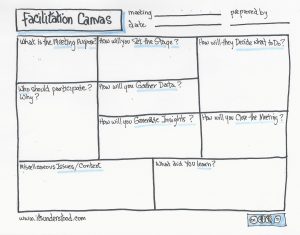
by Susan Johnston | Oct 27, 2017 | Uncategorized |

There’s an old saying, rooted in journalism, that a picture is worth 1,000 words. While we might ask for scientific evidence or challenge the math, most people agree that visuals add enormously to our understanding of things. Humans drew pictures before they developed written language.
 And graphics still convey much important information in our physical world.The visual cortex is the largest system in the human brain – and half the brain is devoted to processing visual information. So it makes sense to supplement our messages with visual information. There are communicators, myself included, who believe we should adapt the Media Richness Theory, which puts face-to-face communication at the top of the scale for conveying information, to add a higher level, face-to-face with a whiteboard.
And graphics still convey much important information in our physical world.The visual cortex is the largest system in the human brain – and half the brain is devoted to processing visual information. So it makes sense to supplement our messages with visual information. There are communicators, myself included, who believe we should adapt the Media Richness Theory, which puts face-to-face communication at the top of the scale for conveying information, to add a higher level, face-to-face with a whiteboard.
All this has led to the evolution and growing popularity of visual facilitation, in which we create images, in real time, to stimulate, focus, enhance and record a discussion. You don’t need to be particularly good at drawing to do this well. The key skill, according to experts, is listening. Sound familiar? That’s the key skill for coaches, facilitators, communicators, product owners, user experience experts and, well, pretty much anyone in a leadership role.
How does visual facilitation help meeting participants?
- Visuals add to their understanding. With more neural tissue devoted to vision than anything else, you stimulate more of
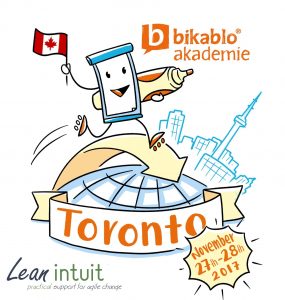 people’s brains with images. They also understand faster. We read images faster than we read text. We “get the picture” with just a glance.
people’s brains with images. They also understand faster. We read images faster than we read text. We “get the picture” with just a glance.
- They’ll remember more of what was discussed. Not only will visual stimulation enhance understanding, it will improve retention and recall. People remember what they see.
- They stay on track. Drawing the discussion encourages focus and prevents people from getting lost in the weeds. If the meeting is about the weeds, that’s a different drawing.
- They may see patterns. As you capture the flow of the discussion, you or the participants may see patterns emerge that might not be noticed with traditional note taking. The picture can depict the flow of ideas, process or products as well as connections between them and their impact on people and things.
- They can see what has been covered in the discussion. Better still, they can clearly see their input has been captured.
- They stay interested longer. Images are just more fun than lists on flip charts. So people will pay attention for longer.
How does visual facilitation help me, as a meeting facilitator?
- You get people’s attention. It’s a big shift from powerpoint, note taking or capturing ideas in an online tool.
- You can capture emotion. Your illustrations can move beyond cold facts and depict the concerns, feelings and reactions of people involved in the discussion.
- You can help people focus on the key elements. What you draw is what they will pay attention to.You don’t have to cover old territory. People can see what has been discussed.
- You can use the finished drawings to share the story with people who were not at the meeting.
You don’t need to be able to draw!
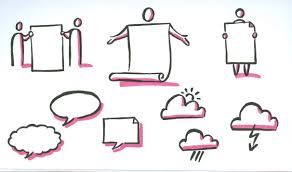
There’s a “visual vocabulary” that anyone can learn. One of this is “bikablo,” a method that emerged in Europe and has caught on worldwide. You master basic techniques for simple illustrations that you can mix. match, adapt and use to tell the story of your meeting. (Leanintuit is bringing bikablo training to Canada – November 27-28. See below for registration details!)
Other ideas to explore:

- Teach your team members to express themselves visually. It encourages collaboration when you all draw together. It’s also a way to engage quiet people and those whose first language is not the team’s working language.
- Attract people to your booth at conferences or trade shows. It will immediately make you stand out from the crowd because something is happening live and in person.
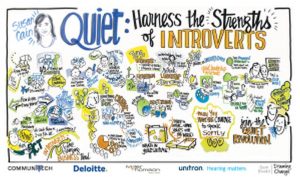
- Capture the proceedings from conference sessions. That way people can see what happened in the concurrent sessions they missed. Or they can gather at the recording of the keynote talk and discuss particular elements. (This graphic, by Sam Bradd, depicts a keynote session I attended at a Communitech conference. A great reminder of Susan Cain’s excellent talk.)
- Create your own illustrations for your presentation slides. This can save you hours of searching through stock image sites. When you create it yourself, you get exactly what you want.
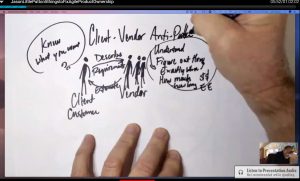
- Draw your presentation. Jeff Patton (see image) and Dave Gray, leaders the agile and user experience communities, respectively, use overhead projectors and sketch out their presentations while they talk. Super engaging!
Training in Toronto – November 27-28
 If you can get to Toronto for a couple of days at the end of November, you have a unique opportunity to learn visual facilitation from the best. We’ve invited Andrea Rawanschad, of the bikablo academie , in Cologne, Germany, to return to Canada and run a second two-day workshop. The first Canadian session, earlier this fall, sold out quickly and was a hit with participants. For those who couldn’t attend the first session – or didn’t know about it – we’ll be gathering in downtown Toronto on November 27 and 28. With a maximum of 12 people in the class, there are just a few spots left, so don’t delay. To learn more and register for this unique experience, follow this link.
If you can get to Toronto for a couple of days at the end of November, you have a unique opportunity to learn visual facilitation from the best. We’ve invited Andrea Rawanschad, of the bikablo academie , in Cologne, Germany, to return to Canada and run a second two-day workshop. The first Canadian session, earlier this fall, sold out quickly and was a hit with participants. For those who couldn’t attend the first session – or didn’t know about it – we’ll be gathering in downtown Toronto on November 27 and 28. With a maximum of 12 people in the class, there are just a few spots left, so don’t delay. To learn more and register for this unique experience, follow this link.
If you have questions – contact me.

by Susan Johnston | Jan 11, 2016 | Build your own skills, Get people talking |
Face-to-face communication is the most powerful business tool we will ever have. So why don’t we use it more often? Or more effectively? Or more consciously?
For over a decade, I’ve been encouraging people to get out from behind their tools and technologies and talk to each other. People nod vigorously. Then they send off an e-mail with a .ppt attached. Or they type something into Jira and feel the product user’s needs are well described. Maybe they post a Tweet, hoping the right people will read it. Have you ever said, “Yes, I talked to [Whomever],” then recall later that what you actually did was correspond in Slack? Tools can fool us into thinking we’re communicating.
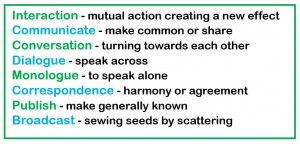 Tools create contact. They can also share certain kinds of information. That is all. We mustn’t confuse that with connection, communication, conversation, dialogue or real interaction that leads to fresh ideas or new ways of working. Yet we do. We see a situation that will create a problem for our project and we send a memo. We need executive support for an initiative and we give them a PowerPoint. We would rather type than talk.
Tools create contact. They can also share certain kinds of information. That is all. We mustn’t confuse that with connection, communication, conversation, dialogue or real interaction that leads to fresh ideas or new ways of working. Yet we do. We see a situation that will create a problem for our project and we send a memo. We need executive support for an initiative and we give them a PowerPoint. We would rather type than talk.
When we use text, whether it’s paper, email, text messages or something else, we may be transmitting information, but not necessarily communicating. Even when we actually are together, we can fail to communicate. Are your meetings a series of broadcast monologues? “I did this yesterday. I’m working on this today. Nothing’s blocking me.” Or do people actually talk about the work they are doing together?
The first value of the Agile Manifesto for software development emphasizes “individuals and interactions over processes and tools.” The meaning of the world “interaction” is a mutual or reciprocal action. In its scientific meaning, it’s a situation in which two or more objects or events act upon one another to produce a new effect. That’s the sort of thing that can happen in a good conversation.
But it’s easy to be distracted by our tools and processes. Maybe it’s because these are things we can measure. Are we having daily stand-up meetings? Tick the box. Retrospectives after every sprint? Tick again. All user stories in the system? Another tick. Tools and ceremonies are useful in creating good work, but they are not going to substitute for a conversation. At best, they can provide a reason to talk. We say, “A user story is an invitation to a conversation.” Do we truly understand what that means?
 The Media Richness Theory, developed in corporate communications in the mid-1990s, ranks communication methods according to how well they reproduce the information sent through them. Face-to-face communication sits at the top. When we’re talking together, we have the benefit of emotional and social cues, through body language and tone. Importantly, we also have a very short feedback loop. We know, at once, if our message has been received. We also have the opportunity to ask for and provide clarification and confirm understanding.
The Media Richness Theory, developed in corporate communications in the mid-1990s, ranks communication methods according to how well they reproduce the information sent through them. Face-to-face communication sits at the top. When we’re talking together, we have the benefit of emotional and social cues, through body language and tone. Importantly, we also have a very short feedback loop. We know, at once, if our message has been received. We also have the opportunity to ask for and provide clarification and confirm understanding.
More recently, Alistair Cockburn created a similar model, based on his own observations on projects. Modified, first by Scott Ambler, later by Chris Chan, it suggests that having a meaningful visual depiction of the information adds even more richness.
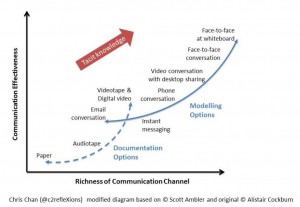 A conversation at a white board, for example, can provide even more meaningful conversation than conversation alone. We have all the richness of a face-to-face conversation with the additional ability to visualize and manipulate information as we discuss it.
A conversation at a white board, for example, can provide even more meaningful conversation than conversation alone. We have all the richness of a face-to-face conversation with the additional ability to visualize and manipulate information as we discuss it.
Some of the most productive conversations are those that are well facilitated. A good facilitator creates a container for thinking together and makes it safe for people to express their ideas. Facilitation provides enough structure to engage people and enough freedom for them to be creative. It encourages full participation and ensures the outcome of the discussion is “owned” by the group and can be implemented. While it often falls to the agile coach or scrummaster, facilitation can be anyone’s job. Helping people talk together is a learnable skill that will increase in value as teamwork and cross-functional collaboration become the norm.
Can we recover the art of conversation? Generations of thinkers and writers have moaned that conversation is becoming a “lost art.” There’s new evidence that it’s true. The most recent call to action comes from Sherry Turkle in her 2015 book, Reclaiming Conversation: The Power of Talk in a Digital Age (Penguin Press, New York). A sociologist, psychologist and MIT professor, she’s been observing the impact of technology on society for over 30 years. She contends that our tools, particularly our “always on” mobile devices, are limiting our ability to hold meaningful, impactful conversations.
We can rediscover and recover this dying art by reminding ourselves of the importance, impact and value of real conversation as a workplace tool – and then doing something about it. We can recognize our tech tools and processes for what they are – processes and tools. We can use them for their intended purposes – but not indulge in the illusion that we are interacting when we use them. Step away from the screens, apps and devices. Step towards the white board with someone who matters. Can we talk? You bet!
In case you missed it: Can we talk? Getting back to conversation – Part 1
by Susan Johnston | Jan 9, 2016 | Build your own skills, Get people talking |
Ten years ago, my writing and conference talks were filled with predictions that conversation would be the Next Big Thing.

2007
Citing evidence from multiple disciplines, I called for organizational leaders to recognize that the desire for connection is a basic human trait and make in-person interaction a deliberate priority. Instead of trying to master blogs, podcasts, email and other tech-centric communication channels, I urged them to get out and talk to people.
But Next Big Thing would not be face-to-face communication. In 2007, along came the iPhone. Mobility became the NBT. And our world changed. Today, our mobile devices keep us “connected” and “talking” to people around the world 24/7. Yet, is it a true connection?
 In her 2015 book, Reclaiming Conversation: The Power of Talk in a Digital Age (Penguin Press, New York), sociologist/psychologist and MIT prof Sherry Turkle suggests our “always on” connections, such as facebook, Instagram, Twitter and thousands of other apps, provide the illusion of communication, but actually impede conversation. We can avoid real conversation by sending a text. We can post a picture rather than engage with someone. We can edit ourselves into a carefully constructed persona that presents someone we are not and will never be. We can post messages to facebook “friends” while ignoring the real friends in the room with us. We can get attention without the unpredictable untidiness of getting close.
In her 2015 book, Reclaiming Conversation: The Power of Talk in a Digital Age (Penguin Press, New York), sociologist/psychologist and MIT prof Sherry Turkle suggests our “always on” connections, such as facebook, Instagram, Twitter and thousands of other apps, provide the illusion of communication, but actually impede conversation. We can avoid real conversation by sending a text. We can post a picture rather than engage with someone. We can edit ourselves into a carefully constructed persona that presents someone we are not and will never be. We can post messages to facebook “friends” while ignoring the real friends in the room with us. We can get attention without the unpredictable untidiness of getting close.
A Gloomy Outlook?
Turkle has spent 30 years investigating our society’s relationship with technology. In this book, her ninth, she descibes offices where workers lay out their multiple devices, don headphones and spend the day exchanging electronic messages in isolation. She describes the “rule of three” – as long as three people in a face-to-face group are actually talking to each other everyone else can be looking at their phones. She quotes people who conduct family discussions by text so they can “fight without saying things [they’ll] regret” – and have a record of who said what. She describes toddlers competing with mobiles for their parents’ attention, new moms texting while nursing newborns, and children who talk about what’s on their phones rather than what’s in their heads. What worries her most is her belief that we are losing the ability to hold real, meaningful conversations.

IBM’s PROFS
Turkle’s work made me examine my own relationship with online communication tools. I’ve used them since pre-Internet days, when I sent email-ish things on the green screens of mainframe terminals. Today, I used tools in “The Cloud,” wherever that is, that we could scarcely imagine 10 years ago – Slack, Twitter, Trello, Ruzuku, Zoom and more. (I’m still waiting for “Beam me up, Scotty.”) They’re handy, yet today’s most valuable and rewarding connections were in cafés, face-to-face with colleagues and clients. I could look them in the eye, feel their energy, sense their presence, offer my full attention and really be with the people I chose to be with.
Text is fine for transmitting information, but it’s not the tool for real communication. A recent text exchange led friends to a weird misunderstanding. Words intended as heartfelt encouragement came off as preachy. The carefully crafted response was interpreted as a snotty retort. Nuance, subtlety, emotion, energy – all missing. Words are not enough. How often have we spent hours crafting careful responses to emails when we should have just picked up the telephone and sorted it out through conversation?
So what can we do?
Which brings us back to Turkle and Reclaiming Conversation. She paints a bleak picture, yet offers hope. We don’t need to give them up, but we need to choose how we use these devices. We can designate tech-free zones, declare a mobile moratorium during meals, establish no-device hours, banish them from meetings. She writes, “If a tool gets in the way of looking at each other, we should use it only when necessary. It shouldn’t be the first thing we turn to.”
We can ask ourselves if our relationship with technology is helping us live better, more fulfilling lives or getting in the way of important moments and real connection. Our insights about the way we use our tools will guide us. The art – make that the gift – of conversation is too important to lose.
Can we talk? Getting back to conversation – Part 2
by Susan Johnston | Jun 9, 2015 | Uncategorized |
 Yesterday, at Agile Coach Camp Canada, I had the privilege of leading a group conversation about taking care of yourself as a coach.
Yesterday, at Agile Coach Camp Canada, I had the privilege of leading a group conversation about taking care of yourself as a coach.
The Big Idea is like the instruction flight attendants give us, “If you are travelling with a child or someone who requires assistance, secure your mask first, and then assist the other person.” As coaches – or as anyone – we don’t have much to give others if we don’t take care of ourselves.
The coaches who gathered for the session agreed that people attracted to the work of helping others often put our own needs behind those of our teams and our organizations. That habit can result in fatigue, stress, and burnout. It impacts relationships both at work and at home.
Here’s the list we built in the conversation:
What can we do to take care of ourselves?
Notice when you’re feeling depleted.
Show yourself some compassion.
Give yourself some space.
– Close the door
– Go for a walk – preferably outside, in a pleasant place
– Physical activity – “I bike to work.”
– Announce it, in a light way. “I let the team know I may be a bit of a Grumpus today.”
Do something you enjoy and are good at
– “I do some real, individual coaching. That lets me see I’m making a difference. It’s almost like a gift to myself.”
Use your network
– “I call another coach and I know I’m not in this alone.”
– “I get coached myself. It’s time I have to focus on me.”
Make your work and success visible
– Personal kanban
– Read your fan mail
– List your successes
– Find a win, however small
Spend some time in reflection
– Journalling
– Mindfulness practice
Let people know what’s fun for you
Manage expectations
– yours and others
– “Accept that our work is messy and it’s a journey.”
Say “no” to more work
– “If you can’t say “No” then your “Yes” can turn into a “Maybe” ”
– “I’d rather disappoint you now, with a “No,” than disappoint you later by being unreliable.”
Gratitude
– Think of things you’re grateful for
– Practise thanking – and accepting thanks
– Appreciate it when others thank you – and show it
– Savour the kudos
Know your purpose and only do what’s aligned with that
Spend some time just doing nothing
– “The brain needs to rest just like any muscle.”
Hugs
– More hugs
One in our group, Gitte Klitgaard, was on her way to a tech conference in New York where her talk was “Stress and Depression – The Taboo and What We Can Do About It.” A link to an earlier version of that talk is at vimeo.com/106927863
Our conversation reminded us that we need to recognize we’re human and show ourselves the empathy and compassion we show our teams and coaching clients.
Note: If you are an agile coach and have never been to an Agile Coach Camp, plan on attending one when you can. They are impossible to describe and they are amazing. There’s one, this weekend, in Calgary, Alberta and one coming up in Washington, DC, August 1st.
 “Running good meetings is THE most important thing we do. I can’t understand why more people don’t understand that.”
“Running good meetings is THE most important thing we do. I can’t understand why more people don’t understand that.” 
 Workshop participants explore the facilitator’s stance and mindset along with the pattern of a successful meeting. Then we get practical. We share tools you can use, right away, for planning, gathering data, generating insights and deciding what to do. We explore maintaining neutrality, team dynamics, dealing with difficult situations (or people).
Workshop participants explore the facilitator’s stance and mindset along with the pattern of a successful meeting. Then we get practical. We share tools you can use, right away, for planning, gathering data, generating insights and deciding what to do. We explore maintaining neutrality, team dynamics, dealing with difficult situations (or people). Facilitation is much more interesting and valuable than people recognize. Maybe that’s because, when done well, it’s almost invisible. So, I think my Scrum Master friend is right. (He often is.) Let’s rebrand facilitation. Let’s call it “Decision Making, Effective Communication and Awesome Teamwork for Any Workplace.”
Facilitation is much more interesting and valuable than people recognize. Maybe that’s because, when done well, it’s almost invisible. So, I think my Scrum Master friend is right. (He often is.) Let’s rebrand facilitation. Let’s call it “Decision Making, Effective Communication and Awesome Teamwork for Any Workplace.”


















